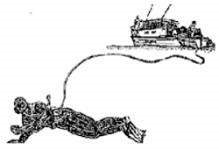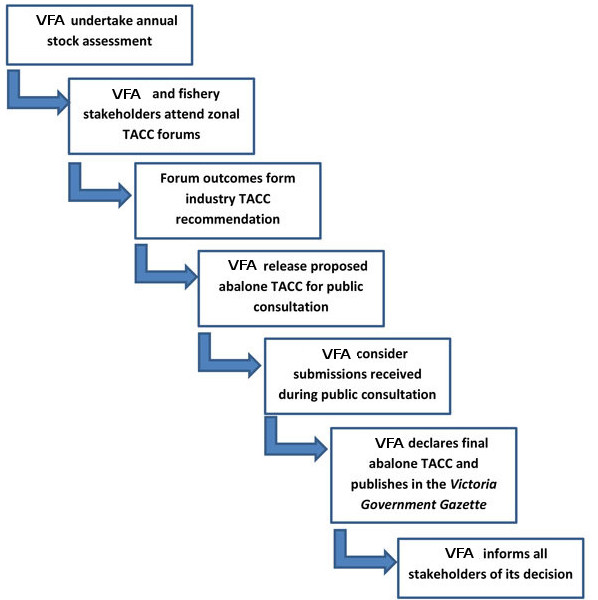Abalone Fishery
Fishery Overview
The Abalone Fishery is one of Victoria's most valuable commercial fisheries. Almost all of the catch is exported to international markets, predominately in Asia. Abalone are caught along the majority of the Victorian coastline and the fishery is primarily based on targeting blacklip abalone (Haliotis rubra). Greenlip abalone are also targeted (Haliotis laevegata). The fishery is quota managed, with a total allowable commercial catch set annually based on the outcomes of a stock assessment process.
There has been a considerable investment in abalone research to assist the management of this valuable resource. Research has focused on understanding the nature and dynamics of the resource. A broad spectrum of information is used to model the behaviour of the fishery and the response of the resource to the impact of fishing. The primary management objective in the Victorian Abalone Fishery is to rebuild the abalone resource to ensure sustainability economic productivity.
Current Total Allowable Commercial Catch (TACC) for the 2024/25 quota season
| Zone | Season | TACC for blacklip | TACC for greenlip |
|---|---|---|---|
| Eastern | 1 April - 31 March | 208.5t | 0t |
| Central | 1 July - 30 June | 215.3t | 3.4t |
| Western | 1 July - 30 June | 41.8t | 1.05t |
Stock Status
Blacklip abalone(Haliotis rubra)stocks within the contemporary fishing grounds are fully fished.
Greenlip abalone (Haliotis laevigata)stocks have limited abundance in the Western and Central Zones.
Abalone Fishing

Abalone is a mollusc (shellfish). It lives on rocky reefs from the shore out into the sea to depths of 30 metres. Abalone is collected by divers who use a chisel-like, iron bar to prise it from the rocks. The divers can stay under water for long periods by using hookah gear (they breathe air supplied to them through an air-hose connected to an air compressor on their support vessel), therefore commercial divers prefer using this, rather than SCUBA gear.
Management Arrangements
The Victorian Wild Harvest Abalone Fishery Management Plan specifies the objectives, strategies and actions for managing the fishery for at least five years from the declaration of the plan.
The commercial fishery commenced in 1962 and during its relatively short history has been subject to fairly intensive management in the form of legal minimum lengths, zonation of the fishery, limited entry and quotas.
There are 71 fishery access licences in the Victorian Abalone Fishery, which is subdivided into three management zones. The licences are distributed across the three management zones, with 14 in the Western Zone, 34 in the central zone and 23 in the Eastern Zone. This means a maximum of 71 divers can operate on any particular day.
Some divers harvest abalone on behalf of more than one licence holder and some holders own more than one licence. Licence ownership may be by individuals or businesses and units of quota may be temporarily transferred among licence holders for the duration of a quota year. The quota year commences on 1 April and continues until 31 March of the following year. The key management controls for the Abalone Fishery are outlined in the table below.
Legal minimum size limits
Element | Commercial Fishery | Recreational Fishery |
Access to fishery | Entry limited to holders of an Abalone Fishery Access Licence Limited number of licences for each fishery zone | Open access Recreational Fishery Access Licence (unless exempt) |
Management zones | Western Zone, Central Zone and Eastern Zone | Statewide |
Output control | Total Allowable Commercial Catch and Individual Transferable Quotas | Daily bag and possession limit |
Size limits | Legal minimum size limits | Legal minimum size limits |
Allowed fishing method & equipment | Abalone tool Skindiving, SCUBA, hookah equipment | Abalone tool Skindiving, SCUBA, hookah equipment |
Other input controls | Permanent closure for greenlip abalone in Port Phillip Bay Fishing only allowed between sunrise and sunset | Permanent closure for greenlip abalone in Port Phillip Bay Fishing only allowed between sunrise and sunset |
Method of monitoring | Quota Management System Random and targeted inspections | Random and targeted inspections |
Commercial Fishery
Western Zone | Central Zone | Eastern Zone | |
Zone boundaries (Figure 1) | South Australian border to Longitude 142o31'E, and south to Latitude 40oS | Longitude 142o31'E to Longitude 148oE, and south to Latitude 39o12'S | Longitude 148oE to New South Wales border, and south to Latitude 39o12'S |
Maximum number of licences | 14 | 34 | 23 |
Number of blacklip individual quota units | 280 | 680 | 460 |
Number of greenlip individual quota units | 14 | 34 | 0 |
Maximum number of licences per boat | Not limited | ||
Minimum quota holding per licence | 5 units | ||
Maximum quota holding per licence/individual | No maximum | ||
For more details on management arrangements for the commercial abalone fishery visit the abalone supplement.
Total Allowable Commercial Catch
The Victorian Fisheries Authority (VFA) undertakes a process to set the Total Allowable Commercial Catch (TACC) for abalone each year. Before setting a TACC, the department undertakes a stock assessment which provides information on the status of abalone stocks. This information is considered by the department and industry at TACC Forums in each management zone. At the forums, a TACC is recommended, through a weight of evidence approach, on a sustainable level of catch. Based on the forum recommendations, proposes a draft TACC for each abalone management zone, which is released for a period of public consultation before making a final decision. The process for setting the abalone TACC is summarised in the flow chart.

Stock Assessment
Stock assessments are used to inform the setting on annual TACCs. The stock assessment gathers data sourced from the fishery as well as independent monitoring.
TACC Forums
Industry TACC Forums are undertaken in each of abalone management zones to consider the information provided by the stock assessment and provide recommendations to the Minister on the TACC and associated management arrangements.
Harvest Strategy
The Abalone Harvest Strategy provides a structured framework for assessing the status of a fishery and a clear set of rules to determine what annual catch limits will be.
Provisions to allow for 10 kilograms over quota on last day of fishing in a fishing period
On 4 July 2017, Hon. Jaala Pulford MP, Minister for Agriculture, signed an amendment to the Initial Abalone Quota Order to allow an Abalone Fishery Access Licence holder to be in excess of his or her quota allocation by 10 kilograms or less on their last day of fishing in a fishing period. The Initial Abalone Quota Order amendment specifies that this amount must be deducted from the quota allocation applying to that access licence in the following quota period.
Enabling commercial abalone licence holders (and their divers) to land up to 10 kilograms above their annual individual quota allocations on their last day of fishing in a fishing period is an action of the current Victorian Wild Harvest Abalone Fishery Management Plan.
Abalone Initial Quota Order and Amendment ![]() [MS Word Document - 26.5 KB]
[MS Word Document - 26.5 KB]
Further Reading
Victorian Wild Harvest Abalone Fishery Management Plan (2015)
Development of Management Strategies for Herpes-like Virus Infection in Abalone
An Epidemiological Analysis of the Events Surrounding a New Disease in Abalone
